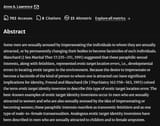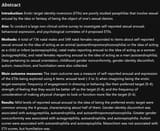Anonymous
ID: fWrKm6jH
7/3/2025, 7:46:01 AM No.509373924
Let's talk about ETLEs and ETIIs, /pol/. Now, you probably haven't heard those abbreviations before. Let me explain.
Based on studies of heterosexual male fetishists, transvestites, and transsexuals, Blanchard (1991) proposed the existence of a hitherto unrecognized paraphilic dimension, erotic target location errors (ETLEs), involving the erroneous location of erotic targets in the environment.
ETLEs can involve preferential attention to a peripheral or inessential part of an erotic target, manifesting as fetishism, or mislocation of an erotic target in one's own body, manifesting as the desire to impersonate or become a facsimile of the erotic target (e.g., transvestism). ETLEs are believed to manifest in men whose preferred erotic targets are women, children, men, amputees, plush animals, and real animals.
Blanchard suggested that these paraphilic sexual interests represented erotic target location errors, i.e., developmental errors in locating erotic targets in the environment. Because the desire to impersonate or become a facsimile of the kind of person to whom one is attracted can have significant implications for identity, Freund and Blanchard coined the term erotic target identity inversion (ETII) to describe this type of ETLE. The best-known examples of ETIIs occur in men who are sexually attracted to women and who are also sexually aroused by the idea of impersonating or becoming women. Also known today as "transgenders".
ETII is a specific type of ETLE, where a person's sexual arousal is directed towards themselves, often in a different physical form or identity. When one's sexual arousal is based on imagining oneself in another physical form (such as an animal, the erotic target is said to be one's self, or erotic target identity inversion (ETII).
Thoughts?
https://link.springer.com/article/10.1007/s10508-008-9446-6
https://pubmed.ncbi.nlm.nih.gov/19308843/
https://en.wikipedia.org/wiki/Erotic_target_location_error
Based on studies of heterosexual male fetishists, transvestites, and transsexuals, Blanchard (1991) proposed the existence of a hitherto unrecognized paraphilic dimension, erotic target location errors (ETLEs), involving the erroneous location of erotic targets in the environment.
ETLEs can involve preferential attention to a peripheral or inessential part of an erotic target, manifesting as fetishism, or mislocation of an erotic target in one's own body, manifesting as the desire to impersonate or become a facsimile of the erotic target (e.g., transvestism). ETLEs are believed to manifest in men whose preferred erotic targets are women, children, men, amputees, plush animals, and real animals.
Blanchard suggested that these paraphilic sexual interests represented erotic target location errors, i.e., developmental errors in locating erotic targets in the environment. Because the desire to impersonate or become a facsimile of the kind of person to whom one is attracted can have significant implications for identity, Freund and Blanchard coined the term erotic target identity inversion (ETII) to describe this type of ETLE. The best-known examples of ETIIs occur in men who are sexually attracted to women and who are also sexually aroused by the idea of impersonating or becoming women. Also known today as "transgenders".
ETII is a specific type of ETLE, where a person's sexual arousal is directed towards themselves, often in a different physical form or identity. When one's sexual arousal is based on imagining oneself in another physical form (such as an animal, the erotic target is said to be one's self, or erotic target identity inversion (ETII).
Thoughts?
https://link.springer.com/article/10.1007/s10508-008-9446-6
https://pubmed.ncbi.nlm.nih.gov/19308843/
https://en.wikipedia.org/wiki/Erotic_target_location_error
Replies:









